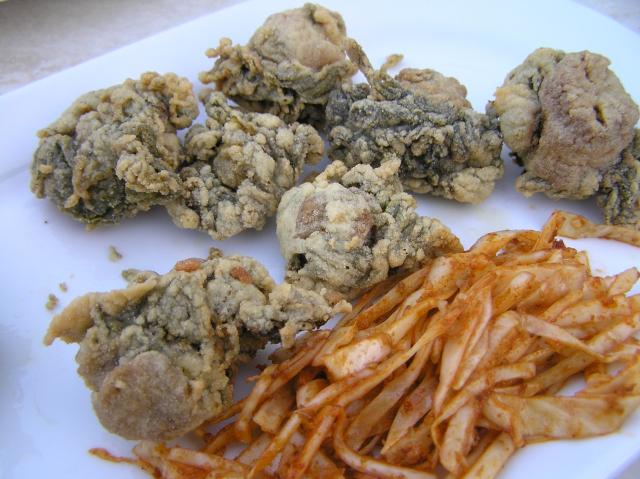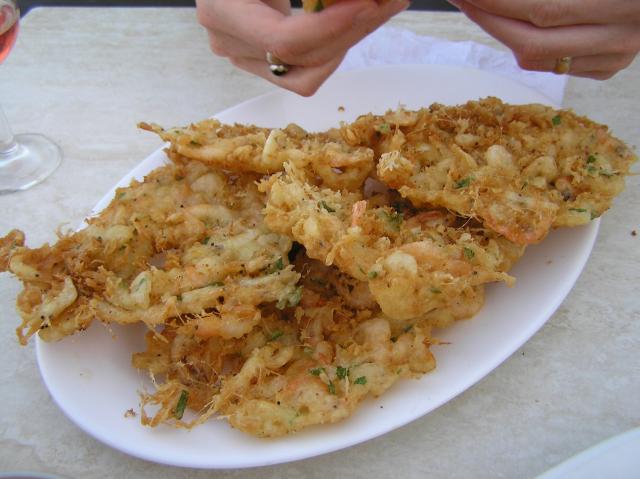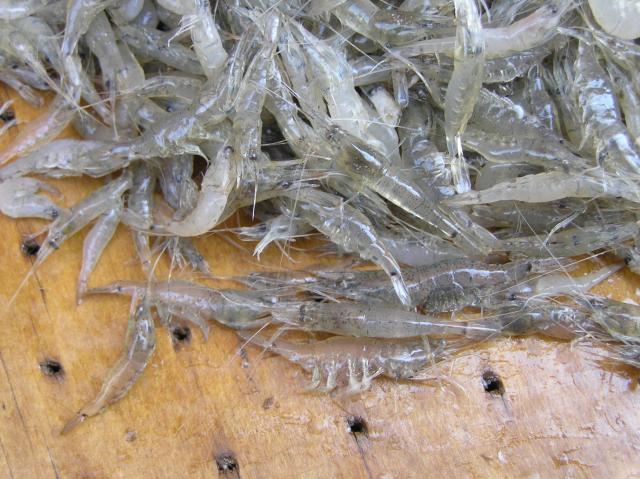-
Posts
4,900 -
Joined
-
Last visited
Content Type
Profiles
Forums
Store
Help Articles
Posts posted by Adam Balic
-
-
American gars and sea-gars are very different fish. This would be called a garfish in Australia (although it is most likely a type of half-beak). Often they are called "green-bones" due to the colour of the bones.
-
13 is a bailer shell of some type.
-
No worries, I should have been more specific in regards to the humour.
Scotland's smoked fish products are excellent. I think that the Irish smoked salmon is often of much better quality then much that is found in Scotland, but the various haddock cures can be exceptional.
Mussels are much better then from the Med in general, Scallops are excellent, clams are less common, but razor clams are 'local' and common. On very rare occasions you can buy 'sand gapers' which are the same species that the American soft shelled clam. Crabs are excellent, as is lobster in season (however, a lot of lobsters sold a live are actually from Canada and sometimes not in the best condition).
Fresh fish can be of very high standard, but getting it can be a problem. Small local fishmongers are not necessarily good. Ditto butchers. If you can find a good greengrocer, then you are very lucky.
Venison is cheap and excellent. I prefer roe deer, but red deer is often more common.
Lamb is good (look out for shetland lamb, which is expectional and rare).
Game is plentiful and cheap. Sort out a game dealer, so that you can get woodcock and snipe (otherwise they go to the trade) pheasant and partridge sell for ~ £2.50, woodcock ~£4, grouse ~£6 each.
Best raspberries on the planet grow in Scotland. Often they are much better from small local stores as they are picked when much riper then those that will go to bigger stores.
-
Any good haggis producer I should not miss?
Quite a few in Edinburgh, but one item that you should not miss is Stornoway black pudding. I don't really like British style blood sausages that much, but this is an excellent product.
-
Can't believe people still think it's okay to be snippy about Scottish food. Particularly when they come from a country where you can smoke in dining rooms *.
I'm not resident in Glasgow, but go when football demands. From those visits I'd recommend trying Stravaigin, Gamba, Ubiquitous Chip, The Sisters and No. 16. Plenty more suggestions here, here and here.
Also, just noticed that Brian Maule, former head chef at Le Garvoche, has a place that seems not to have been mentioned on EG before. Anyone been? (London readers may wish to note: lunch £14.50 for two courses, £17.50 for three. Six course taster in the evening for £38.)
You can go back to your jokes about haggis pizza and deep fried confectionery now ...
* edit disclaimer: not that any English had been snippy yet. But I've been down this road before, and felt it sensible to head it off at the pass.
The lady doth protest too much, methinks?
I don't think that I placed any value judgement on the pizza at all did I (no mention of deep fring it either?), you seem to have done that yourself. If you want an informed opinion on what I think of Scottish food then read this. Not sure what the smoking issue or the comparison of cost of living in London with Glasgow has to do with the issue either?
There are excellent aspects of the food culture in Scotland and really terrible things as well. To ignore either extreme doesn't reflect the over all reality of the situation.
Alberto - one piece of advice, be extremely circumspect in regards to any form of critism of any aspect of Scottish culture in public.
-
Actually, the base was OK, but the haggis wasn't very good quality.
-
Welcome to the future my friend.


-
What do you call those leathery-topped ones with the yellow spongey undersides? They're some relation to cepes, no?
Yes, there are about 20 varieties of cepes around to pick.
The truffles, well dogs, luck and abit of knowing where to look!! (I'm not allowed to say any more than that!!)
"Cepe" is a French name for an individual species, Boletus edulis isn't it? The bolete with the yellow underside are "Slippery Jacks" (Suillus luteus)? Sorry for being a pedantic pain, but I have seen a few people mention that many of the 'Cepes' sold in London are not actually Boletus edulis, which may be slightly fraudulent or it may be a case of nomeclature change, in that "Cepe" seems to cover all Boletes in the UK?
Excellent photograph BTW, do you prepare the honey fungus in any special way to avoid tummy upsets?
-
The major reason why barberries where lost from Anglo-cuisines was due to it's deliberate eradication. It has (or was thought to) have a symbiotic relationship with the rust (fungus) disease Puccinia graminis of wheat. There are lots of 19th century articles about this in the UK and USA.
It is easy enough find in middle eastern stores. One issue in historic English/american recipes is that the fruits seem to be more often candied or preserved in syrup then dried, so there is a difference there.
The dried fruit when fresh is a bright red colour and soft, as it gets older it becomes harder and a dark brown colour, not nearly as nice.
I'm not sure that it would be allowed into Australia, due to the rust issue, but I have seen barberry fruit leather and syrups of sale in Melbourne.
This galantine is adapted from a 17th century English recipe by Robert May. The red flecks are barberries.

-
Two items I realy wanted to try in Sanlucar where fried sea anemones (ortiguillas) and the famous tortillas de camarones, which are crisp fritters made of tiny shrimp, wheat and chickpea flour. So being an idiot I ordered both at the same time. Delicious, but maybe a little too much fried food at once.
Ortiguillas and cabbage salad. The former has not much texture, merely a bite of mild creamy sea flavour. Suprisingly good.

Tortillas de camarones. These are about 90% shrimp, which are tiny and cooked with their shells, which flavour the fritter. I saw these shrimp for sale at the market, where they hopped about like fleas. I have seen similar shrimp sold at the Rialto market in Venice, you can tell who has bought them by the rustling sound the shrimp make in the paper cones they are sold in. The tortillas were just fantastic, perfect with salty manzanilla. I felt a little ill after eating so many though.

After 16 months or so I visited Sanlucar again last week. Essentially, it was a very similar relaxing week, but a couple of points from the last trip are worth addressing.
The deep fried sea anemones are shown here as they are sold at the market. From this I would guess that they are the type known as "Snake-lock" anemomes in english.

The shrimp for the tortilla were sold by individual ladies in the alley leading up to the market entrance. I saw no evidence that they were sold within the market itself, so maybe catching and selling these is a very small scale enterprise? You can see the shrimp being sold here on the right.

The shrimp themselves are tiny (2-3 cm) and I thought that they may be larval stages of some large shrimp that are common in the area. However, on close examination, so of them did appear to be have eggs, so prehaps some of them are adult stage at least.

-
Ah thanks very much. I am going to make an attempt at growing my own when I get back, so it is good to know that epazote seeds are availble as that is one item that I was thinking I would have to do without.
-
Information.
-
I don't have a huge amount of experience with Japanese curries, but my impression is that there is way more depth of flavor in Indian curries. To those who prefer Japanese curries, what is it that you prefer about them?
India has a spice culture, while Japan has an umami culture, and curry was introduced into Japan via England. Thus, Japanese curries are a perfect blend of the two cultures and the Western culture.
That being said, I have to admit that the tastiness of Japanese curries derives from the amounts of lard and MSG used.

Yes, I guess the more accurate comparison would be of Japanese 'curry' and the old style British 'curry', using curry powder or paste (and which doesn't really resemble anything found in the subcontinent).
-
-
I was given a bottle of "Uhudler" recently, I believe that is is quite rare even in Austria. This was a rose wine, quite dry, and as soon as I smelt the glass I knew it had some Vitis Labrusca ancestory - grape bubble-gum flavour.
-
Do you know if the animal you got was male of female? If it was the former it is possible that what you were smelling was "Boar Taint". Not very pleasant at all when you detect it.
-
The wild boar I have had has varied a great deal. While the hunt killed boar for Italy has variation from animal to animal, in general it has been lean and darker meat. The farmed whild boar I have had, to date in the UK, has been a pale meat and counter intuitively, quite mild with a good fat coverage. In some cases the meat was actually milder in flavour then domestic pork.
I think that it would be a good idea to wait until you see the meat, before making concrete plans as some recipes/treatments may not be appropriate?
-
.... I had to "respectfully disagree" with his assertion that "such langugae has no place in a written text, no matter the circumstance" and "such language negates any educational or reference value of the text." And I "assured" the complaintant that future issues would almost certainly contain more of the language that has so upset him.
Send them a copy of "Lady Chatterley's Lover" and copy of the censorship trial?
-
As far as Profanity in Food Writing goes, did MFK Fisher ever use it?

SB (and she touched deftly upon some rather "seamy" topics in her work)
I would think that her description of a girl pushed over the edge of sexual arousal into a stupor, along with the description of the girls pubic hair as a autumn leaf, would have been considered quite profane at he time?
-
I don't have a problem with most of these individual words and I think that overt removal of them does amount to a form of censorship. However, in terms of food writing (or any other writing) the idea is to sell the article to an audience. Therefore, in some cases the use of fuck etc, is quite a useful devise (gritty, making it real) and obviously works well for instance, in other cases it will just turn your audience off.
I was reading a cookbook on Arabic food the other day and was quite surprised to see c*** in print. It seems that in some arabic speaking countries "cous" is slang for female genitalia. So you never quite know who you might offend.
What I find offensive in food writing, is beautiful prose with no data or references, which unfortunately gives the impression of substance, but is by an large just opinion.
-
This article is from a few years ago, but is still the best piece I have seen. There is no simple answer, as there are a lot of variables, but a carnivorous fish obvious have to eat something and depending on what source you believe it takes 2-5 kg of industrial fish to produce a kg of farmed fish.
-
Thw Eel population has dramatically crashed (~90%) in the last decade or so and the native (white clawed) crayfish is declining rapidly due to the introduction of the American signal (red-clawed) crayfish. In regards to catching crayfish in the UK, I believe that the white clawed crayfish is protected? What were Ramsay et al catching?
That's very good. There was once a pudding made in the Thames valley which was a suet crust stuffed with the tails meat, with herbs et al, the shells were cooked until dry and powdered, then added to the suet crust. When I move back to Melbourne I will try this with yabbies.
-
Pret A Manger has them in abundance. Frozen or other ways preserved they are not worth eating.
-
My personal knowledge of early culinary history in Western Europe is very limited, however, it is my understanding that the discussion of heavy seasonings, odd combinations and "exotic" meats concerns exceptional dining practices, such as banquets among the elite. The variety and quantity of produce, dairy, fats and protein we consume in a single meal is one of the major distinctions between contemporary diets in the "West" and those of Greco-Roman and medieval civilizations, no? Rarely if ever do I manage to eat the 10-12 recommended daily servings of grain-based products, preferring to focus on fruits and vegetables at this time of year. Yet, bread, porridges and other forms of cereals were the principal components of the two meals consumed by those fortunate enough to have something in the pantry* "back then." According to my reading, medieval Italy compares to Ancient Greece in referring to food as "bread" and "that which is eaten with bread."
*Yes, the roots of the word "larder" are Middle English according to one of the tools on my computer's dashboard. From lardier and further back, lardarium. Meat vs. panterie, paneter, panarius, panis, bread.
Quite right, but in general the diets of everyday folk are never really recorded in detail. The types of works that do survive, tend to survive because they don't have titles like "100 ways with mush".

Also, modern western diets are a pretty recent thing.
Regarding words and bread, "Lord" is thought to derive from OE "hláfweard", which means "Bread Keeper". Bread is the staff of live after all.



Shanghai Fish Identification challenge
in China: Cooking & Baking
Posted
3 would usually be identified as a coral-trout (Plectropomus spp.)